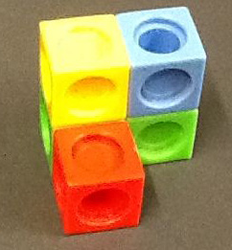Or search by topic
Number and algebra
Geometry and measure
Probability and statistics
Working mathematically
Advanced mathematics
For younger learners
Oblique Projection



- Problem
- Teachers' Resources
 Here is another view of the multilink structure discussed in 3D Drawing.
Here is another view of the multilink structure discussed in 3D Drawing.
Draw it in Oblique Projection - you may find using squared paper helpful.
Now try drawing it again, this time with a different face as the front.
Which properties of the original structure are preserved in your drawings, which are not? You should think about:
- the relationship between the lengths of the edges of the cubes
- the angles between them
- parallel and perpendicular lines
What do you think the advantages of Oblique Projection are? What disadvantages are there with this method of representing 3D objects in 2D?
You may also like
Soma - So Good
Can you mentally fit the 7 SOMA pieces together to make a cube? Can you do it in more than one way?
Nine Colours
Can you use small coloured cubes to make a 3 by 3 by 3 cube so that each face of the bigger cube contains one of each colour?
Take Ten
Is it possible to remove ten unit cubes from a 3 by 3 by 3 cube so that the surface area of the remaining solid is the same as the surface area of the original?

